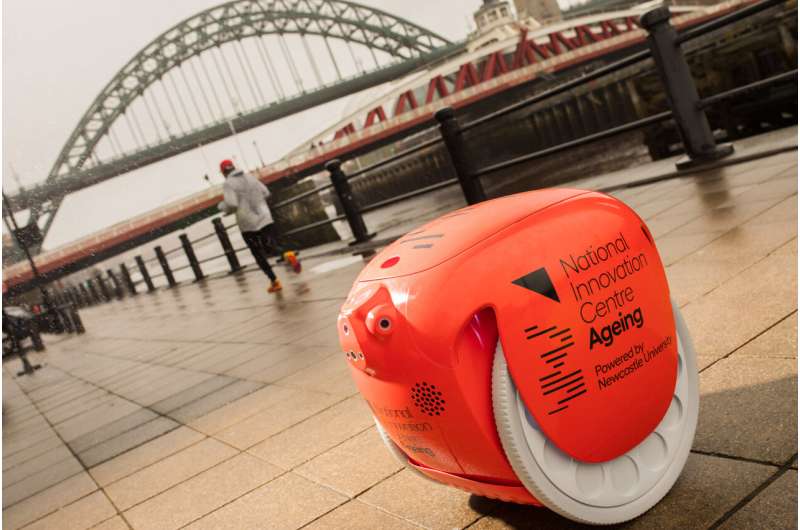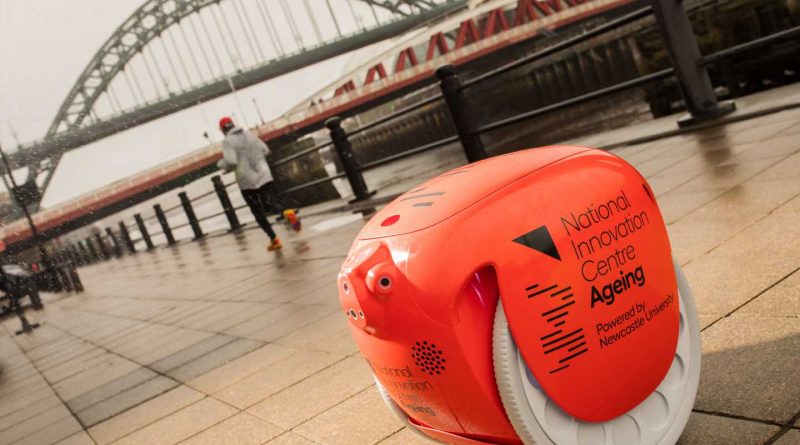Human-following robots have potential to promote healthy aging, study shows

Newcastle University research has shown that human-following robots can support the mobility and well-being of older people.
Published in the journal Scientific Reports, the study reveals that human-following robot has the potential to provide social benefits to an independent older adult by encouraging walking trips and prompting social interaction with others in the community.
The researchers showed videos of an older adult interacting with a human-following robot (the Piaggio Fast Forward’s Gita) in a real-world setting to the study participants and analyzed their feedback and requirements. The Gita robot is designed to follow humans while also being able to carry cargo. This robot can move on its own wheels and can carry up to 18 kg of items in its internal cargo compartment as it follows its user.
The participants, with an average age of 75, indicated that the robot would physically support them when out on a walk and alleviate pressure while walking through removing the need to carry and offer as a seat for rest when needed by an elderly user, especially for local shopping trips. Several participants also suggested that the robot would be useful for carrying other items to support them while on their walk.
The results also show that the robots can facilitate social interactions, such as gaining potential attention and acting as a talking point for conversations.
Other aspects the researchers investigated included the perceived benefits for others in the communities, issues of the human-following robots and requirements for improvements.
Many of the participants discussed that they did not yet need the support of a human-following robot given that they could still carry belongings or drive, but it could be useful for maintaining their mobility and independence if their health was to decline or their circumstances change in future.
Lead author, Dr. Shuo Li, Research Associate at Newcastle University’s School of Engineering, said, “Our research demonstrates how future mobility and robotic innovations have the potential to address the global challenge of aging. Follow-up research is currently underway to examine and quantify older adults’ interaction with a human-following robot in a real-world context.”
The publication is based final-year research undertaken by former Master of Engineering (Meng) student, Kirsty Milligan, who was supervised by Professor Phil Blythe and Dr. Shuo Li.
The Civil Engineering graduate said, “My research project was a valuable opportunity for me to try something a bit different as part of the final year of my MEng degree, and it was really interesting to explore whether such an innovative technology has the potential to support active aging.”
“I enjoyed talking to the participants and hearing their thoughts on the robot, as well as learning more about research methods and qualitative data analysis. It is really exciting that a paper based on my work has been published, and I hope it inspires others to further explore the use of these types of technologies by older people. I’ll be interested to see where future research in this area goes, and if maybe we will see these types of robots in everyday use one day.”
The Gita robots are being tested by the team at the National Innovation Centre for Aging (NICA) on Newcastle Helix, where they study human experiences and interactions with the robots and explore user acceptance.
Study co-author, Professor Nicola Palmarini, Director of the UK’s National Innovation Centre for Aging (NICA) based at Newcastle University said, “This is an example of how emerging technologies can help tackle and mitigate isolation and support older adults’ engagement in outdoor activities, a crucial driver to population’s health and longevity.”
“This is a great example of what we have defined as ‘Aging Intelligence’ at work and is part of our wider research on supporting mobility for our older citizens.”
Study co-author, Professor Phil Blythe, Professor of Intelligent Transport Systems, and head of the Future Mobility Group, Newcastle University, added, “We believe that research into supporting the mobility of older people and ensuring they have transport systems and services that are fit for purpose is critical for a fair and leveled up society, this is one of the key areas of my groups research where we are always looking for future technologies that can improve the mobility of all.”
The researchers argue that while these robots offer advantages, there is a need for additional improvements to their design to fully support older people. It is crucial to take into account the needs and demands of older individuals when creating and advancing age-friendly robots that can follow humans.
Limitations highlighted in the study include the possible negative interactions between the robot and others. The researchers suggest considering future iterations of the robot that address these concerns, such as implementing a security system that connects to a remote operator.
According to the study’s results, robot developers and innovators must focus on improving the robots’ ability to navigate curbs, steps, and diverse terrain for them to be practical for most elderly people.
More information:
Shuo Li et al, Exploring the role of human-following robots in supporting the mobility and wellbeing of older people, Scientific Reports (2023). DOI: 10.1038/s41598-023-33837-1
Journal information:
Scientific Reports
Source: Read Full Article
